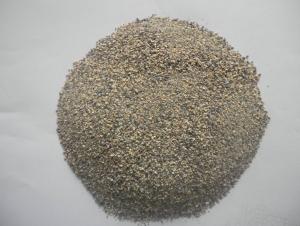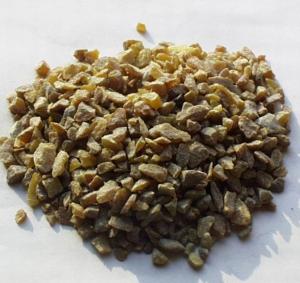White Fused Alumina - Raw Materials for Refractory
- Loading Port:
- China Main Port
- Payment Terms:
- TT OR LC
- Min Order Qty:
- -
- Supply Capability:
- -
OKorder Service Pledge
OKorder Financial Service
You Might Also Like
Specifications
White Fused Alumina ( WFA OR WA) is made from chemical by high furnace or tilting furnace at high temperature . it is very impor
White Fused Alumina
White Fused Alumina ( WFA OR WA) is made from chemical by high furnace or tilting furnace at high temperature . it is very important raw material for advanced refractory and abrasives. Its properties are as following :
Property | Size 0-1 1-2 3-5mm |
| Fine (mesh) 0-180 0-320 |
|
|
| Spec | Typical Value | Spec | Typical Vlalue |
|
a-Al2O3 | 99%Min | 99.5% | 99%Min | 99.2% |
|
SiO2 | 0.2%Max | 0.08% | 0.2%Max | 0.12% |
|
Fe2O3 | 0.2%Max | 0.01% | 0.25%Max | 0.05% |
|
Na2O | 0.4%Max | 0.23% | 0.4%Max | 0.30% |
|
Principal crystalline Phase | a-Al2O3 |
Crystal systerm | Hexzagon |
Color | White |
True density | 3.95Min |
Bulk density | 1.75-1.95 |
Mohs hardness | 9 |
Size (mm) | 85 53 31 10 |
Fine(Mesh) | -80,-120,-240,-320 |

- Q: Does the external wall thermal insulation materials level b1 need the fire barrier zone?
- First, the cotton fire barrier zone "rock wool board" mainly uses water-repelling rock wool board produced by pendulum method as thermal insulation layer materia, and connecting and fixing base wall by binding and nail bonding, it is composed level A non-combustible building energy efficiency thermal insulation system by plastering layer composed by plastering mortar and glass?fiber mesh and decorative mortar finishing layer or coating. Rock wool board exterior insulation system, low thermal conductivity, good ventilation, combustion performance advantages of higher levels can be used in new construction, expansion, renovation of residential buildings and public buildings energy-saving exterior wall insulation works, including exterior insulation, fire Barrier non-transparent wall insulation and EPS external thermal insulation system. The introduction of main level A fireproofing EIFS on the present market (The following text is selected from China Building Standard Design and Research Institute " external wall thermal insulation building construction" Standard No. 10J121) Second, the foam concrete fire barrier zone 1. It is very green without the release of irritant and harmful gases; no mineral cotton floats do harm to human skin and the respiratory tract; production of?toxic?gases is security level (AQ1), there is no harmful gas and waste emissions and less carbon emissions; it exist not duplicate insulation demolition waste to pollute the environment.
- Q: Who knows the refractoriness of high temperature lightweight firebricks?
- pores of high temperature lightweight refractory bricks is made by lightweight aggregate such as combustibles, foaming?agent, and hollow?sphere production with better thermodynamic stability. Refractoriness reaching 1200 ℃ or more is first grade refractories. fire resistance of building blocks of 100mm thick can reach 225 minutes, 200mm thick brick 480 minutes.
- Q: Are the specification of fireclay bricks and ordinary clay brick the same?
- Do you want to know whether the specifications of fireclay bricks and ordinary clay brick are the same?
- Q: Why does refractory need to add coarse firstly and then add fine aggregate?
- Adding coarse aggregate is to assure its good combination with fine aggregate. This is just the experience. You don't have to ask.
- Q: What substitutes are available for high-end refractories in addition to zircon sand?
- If you want to use environmentally friendly products, please use recycled Mo powder.
- Q: What are the main characteristics of the sic refractories?
- 1. The usage temperature of silicon carbide refractory is generally 1760 ℃ 2. The silicon carbide refractories can withstand dramatic changes in temperature, and a good thermal shock resistance performance. To prevent the cracking or breaking of lining refractories. 3. Under the conditions of high or low temperature, it can withstand a certain compressive stress. 4. Under the conditions of high or low temperature, it can withstand friction. 5. It can withstand the huge hydraulic pressure or buoyancy of the metal. 6. It can also withstand the effect of furnace gases to prevent the infiltration of other refractories and reactions.
- Q: Can anyone tell me what is a high alumina refractory?
- High alumina refractories: High-alumina refractory products have high refractoriness, compressive strength and refractoriness under load, which are used for building the high-temperature parts of various large blast furnaces, such steelmaking furnace, airheater, electric furnace, rotary?kiln and other thermal equipment.
- Q: Introduction to refractory material
- Refractory material refers to inorganic non-metallic materials with refractoriness of no less than 1580℃. Refractoriness refers to the centigrade temperature of refractory cone sample in the case of no load when resisting high temperature without softening. But the refractoriness alone cannot descript the refractory material, thus 1580℃ is not absolute. Now refractory material is defined as material used in high temperature allowed by its chemical properties. Refractory material is widely used in metallurgy, chemical industry, petroleum, machinery manufacturing, silicate and power industrial area, of which the application in metallurgy accounts for the largest part of 50% ~ 60% of total output.
- Q: What are the uses of refractory materials of glass furnace?
- crown--high-purity silica bricks; wall--melting end 41# fused zirconia corundum bricks with no shrinkages(41% of zirconium, similarly hereinafter), cooling end 33# fused zirconia corundum bricks with no shrinkages; bottom--33# fused zirconia corundum bricks(with shrinkages); breastwork--33# fused zirconia corundum bricks(with shrinkages); port--33# fused zirconia corundum bricks(with shrinkages); regenerator chamber--the upper part is for magnesite-chrome bricks, the bottom part is for high-duty fireclay bricks; checker--the upper part is for high purity magnesia bricks, and the bottom part is for magnesite-chrome bricks; flue--clay bricks.
Send your message to us
White Fused Alumina - Raw Materials for Refractory
- Loading Port:
- China Main Port
- Payment Terms:
- TT OR LC
- Min Order Qty:
- -
- Supply Capability:
- -
OKorder Service Pledge
OKorder Financial Service
Similar products
Hot products
Hot Searches
Related keywords
























